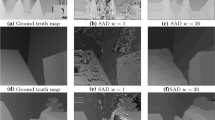Abstract
Stereo matching, which is conventionally used for three-dimensional (3D) information acquisition through cameras, is the most actively studied subject in computer vision. To obtain sophisticated 3D information, refining the disparity map in stereo vision is important. The weighted median filter (WMF) is extensively used to eliminate outliers in post-processing. To this end, various studies have implemented WMFs in hardware for real-time processing. Among them, the separable weighted median filter (sWMF) vertically and horizontally separates a two-dimensional WMF into two one-dimensional WMFs to reduce hardware resource usage. Herein, we propose a hardware architecture that can reduce the hardware resource usage of the sWMF by applying the sparse-window approach, which is a method of creating a window by selecting pixels sparsely. This approach makes it possible to reduce drastically the number of elements to be computed. Although the proposed architecture has an insignificant disparity error rate, similar to that of the sWMF, it saves 33% slice lookup tables (LUTs) and 69% slice registers when using a window size of 37 × 37 pixels as the synthesis result on the Xilinx XC7K325T FPGA. When a window size of 49 × 13 pixels with the best performance is used, the proposed architecture uses 7335 slice LUTs, 4126 slice registers, and 21 block RAMs. The proposed architecture operates at frequencies of up to 167.95 MHz; hence, it can operate in real time. The proposed WMF architecture is suitable for application in embedded systems and low-resource environments as it is hardware-friendly.














Similar content being viewed by others
References
Brownrigg DRK (1984) The weighted median filter. Commun ACM 27(8):807–818
Chen S, Zhang X, Sun H, Zheng N (2017) sWMF: separable weighted median filter for efficient large-disparity stereo matching. IEEE International Symposium on Circuits and Systems, In, pp 1–4
Choi S, Jeong JC, Chang J, Shin H, Lim EG, Cho JI, Hwang D (2015) Implementation of real-time post-processing for high-quality stereo vision. ETRI J 37(4):752–765
Fahmy SA (2008) Generalised parallel bilinear interpolation architecture for vision systems. International Conference on Reconfigurable Computing and FPGAs, In, pp 331–336
Fahmy SA, Cheung PYK, Luk W (2009) High-throughput one-dimensional median and weighted median filters on FPGA. IET Comput Digit Tec 3(4):384–394
Gavrila DM, Philomin V (1999) Real-time object detection for “smart” vehicles. IEEE International Conference on Computer Vision, In, pp 87–93
Gelautz M, Stavrakis E, Bleyer M (2004) Stereo-based image and video analysis for multimedia applications. International Archives of Photogrammetry, Remote Sensing and Spatial Information Sciences, pp 998–1003
Hirschmuller H (2008) Stereo processing by semiglobal matching and mutual information. IEEE Trans Pattern Anal Mach Intell 30(2):328–341
Horisaki R, Irie S, Ogura Y, Tanida J (2007) Three-dimensional information acquisition using a compound imaging system. Opt Rev 14(5):347–350
Huang T, Yang G, Tang G (1979) A fast two-dimensional median filter algorithm. IEEE Trans Acoust 27(1):13–18
Hyun J, Kim Y, Kim J, Moon B (2020) Weighted median filter architecture based on the sparse window approach. The International Workshop on Future Technology, In, pp 50–53
Ji X, Wang Q, Chen BW, Rho S, Kuo CCJ, Dai Q (2016) Online distribution and interaction of video data in social multimedia network. Multimed Tools Appl 75(20):12941–12954
Justusson BI (1981) Two-dimensional digital signal processing II: transforms and median filters. In: Huang TS (ed) Median filter: statistical properties, 1st edn. Springer-Verlag, Berlin, Heidelberg, pp 161–196
Kanbara M, Fujii H, Takemura H, Yokoya N (2000) A stereo vision-based augmented reality system with an inertial sensor. IEEE and ACM International Symposium on Augmented Reality, pp 97-100
Menze M, Geiger A (2015) Object scene flow for autonomous vehicles. IEEE Conference on Computer Vision and Pattern Recognition, In, pp 3061–3070
Paliwal N, Vanjani P, Liu JW, Saini S, Sharma A (2019) Image processing-based intelligent robotic system for assistance of agricultural crops. Int J Social and Humanistic Computing 3(2):191–204
Park SY, Subbarao M (2005) A multiview 3D modeling system based on stereo vision techniques. Mach Vis Appl 16(3):148–156
Perez-Andrade R, Cumplido R, Feregrino-Uribe C, Del Campo FM (2009) A versatile linear insertion sorter based on an FIFO scheme. Microelectron J 40(12):1705–1713
Pollard SB, Frisby JP (1990) Transparency and the uniqueness constraint in human and computer stereo vision. Nature 347(6293):553–556
Yang Q (2014) Hardware-efficient bilateral filtering for stereo matching. IEEE Trans Pattern Anal Mach Intell 36(5):1026–1032
Yang Y, Yuille A, Lu J (1993) Local, global, and multilevel stereo matching. IEEE Conference on Computer Vision and Pattern Recognition, In, pp 274–279
Yang Q, Tan KH, Ahuja N (2009) Real-time O(1) bilateral filtering. IEEE Conference on Computer Vision and Pattern Recognition, In, pp 557–564
Zhang Q, Xu L, Jia J (2014) 100+ times faster weighted median filter (WMF). IEEE Conference on Computer Vision and Pattern Recognition, In, pp 2830–2837
Zhu S, Li Z, Yu Y (2014) Virtual view synthesis using stereo vision based on the sum of absolute difference. Computers & Electrical Engineering 40(8):236–246
Acknowledgements
This research was supported by Basic Science Research Program through the National Research Foundation of Korea (NRF) funded by the Ministry of Education (NRF-2016R1D1A3B01015379).
Author information
Authors and Affiliations
Corresponding author
Additional information
Publisher’s note
Springer Nature remains neutral with regard to jurisdictional claims in published maps and institutional affiliations.
Rights and permissions
About this article
Cite this article
Hyun, J., Kim, Y., Kim, J. et al. Hardware-friendly architecture for a pseudo 2D weighted median filter based on sparse-window approach. Multimed Tools Appl 80, 34221–34236 (2021). https://doi.org/10.1007/s11042-020-09906-2
Received:
Revised:
Accepted:
Published:
Issue Date:
DOI: https://doi.org/10.1007/s11042-020-09906-2




